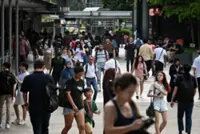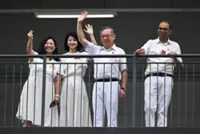
When The Straits Times visited Jurong East station at 5.30am on Oct 1, digital boards and signs showed that all MRT services on the line had resumed. - ST
SINGAPORE: Train services between Jurong East and Buona Vista MRT stations along the East-West Line have resumed since the start of passenger service on Oct 1, after extensive track damage downed train services for six days.
When The Straits Times visited Jurong East station at 5.30am on Oct 1, digital boards and signs showed that all MRT services on the line had resumed.
Signs that previously directed passengers to a temporary shuttle train service towards Boon Lay station had been removed.
The first eastbound train arrived just after 5.40am.
From 5.45am, ST observed that eastbound trains were arriving alternately at a steady pace, with at least one empty train unavailable for boarding passing through the station after the departure of each train serving passengers.
Westbound trains travelling on sections of repaired track, such as those between Dover and Clementi stations, will observe a temporary speed limit of 40kmh till Oct 3 as part of a standard process after rail replacements. Trains typically travel at speeds of between 60kmh and 80kmh.
Passengers heading westwards on the East-West Line have been advised to factor an extra five minutes into their travel time.
Passengers interviewed by ST were happy that train services along the affected stretch had resumed.
Canmy Lim said she was relieved that she was able to travel eastwards from her home in Jurong East to her workplace in Buona Vista via the MRT “as per normal”.
The 42-year-old, who works in customer service, said it was “okay” that trains heading westwards were travelling slower, as long as services along the stretch were running.
Childcare centre cleaner Kavitha Simachallan said she was happy and thankful to restart her usual commute from Jurong East to her workplace in Clementi, which is one stop away. The 44-year-old had to take a bridging bus from Jurong East to Clementi stations when train services went down.
Student Seow Yi Xin, 16, was grateful for the restoration of train services, despite the slower train speeds of westbound trains. The commute from her home in Dover to her school in Boon Lay for the past few days took an hour and 15 minutes by bus.
It would normally have taken her 45 minutes with the MRT running.
She added that it was fine that trains were moving slower. On Oct 1, she left home earlier to reach her school by 7.45am.
To medical technologist Ong Shi Jie, the westbound trains were not moving significantly slower. The 35-year-old, who was travelling from her Bishan home to her office in Jurong East, said there was “not much of a difference” in waiting times.
When train services were down in the last few days, she took 1½ hours to get to work, first via the Circle Line to Buona Vista and then a bridging bus between Buona Vista and Jurong East. If services on the East-West Line were not disrupted, her commute would take about 40 minutes.
Services along the four-station stretch between Jurong East and Buona Vista were disrupted on Sept 25, when a faulty first-generation Kawasaki Heavy Industries train, which had been in service for more than 35 years, encountered a fault near Clementi station at about 9am.
As it was being withdrawn from service to Ulu Pandan Depot, a defective component on the train’s undercarriage – known as an axle box – dropped onto the tracks near Dover station.
This caused the wheels of the undercarriage to run off the rail. The severe damage triggered a power trip that stalled other trains and crippled rail services.
Among the equipment that was damaged were three point machines that divert trains onto different tracks, stretches of the third rail that supplies power to trains, and power cables.
Extensive repairs and replacement work had to be done, followed by tests of the track and trackside equipment for passenger safety before services could be restored.
The six-day disruption is Singapore’s second-longest, affecting more than 2.1 million passengers.
The longest disruption on record is the stoppage of MRT services between Joo Koon and Tuas Link stations in November 2017, after a software glitch in the signalling system resulted in two trains colliding at Joo Koon. The suspension of train services between Joo Koon and Gul Circle stations was later extended till mid-2018, when the East-West Line switched to a new signalling system. - The Straits Times/ANN









































